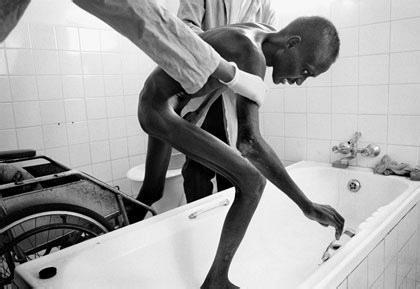抵抗艾滋病--英语作文1篇
Aids has become one of the most terrifying desease in todays's world.It has been caculated that if we don't take measures soon enough,the hole human race will be under siege!
To fight against Aids,we definitely need to work together,basicly,
we shall realize first of all,this kind of desease is never too far from ourselves,it is eccencial for every one of us to learn about neccesary ways to prevent it from happening.
People who had been infected should not never be regarded as criminals,in fact, many of them are just harmless as we are.In this case,any forms of discrimination shall be regarded as illegal.
Furthermore, we must solve the problem through global cooperation,
only if we stick together,can we possibly give Aids a final strike.
抵抗艾滋病--英语作文2篇
The uniting of the world around the AIDS epidemic is without prior example. As the number of AIDS cases around the world rapidly increases, nations are showing great focus in battling this common enemy ― attacking rich and poor countries the same.
By 1989, almost every nation on earth had established a program educating its people about AIDS, according to Jonathan Mann, director of the World Health Organization's (WHO) International Program on AIDS. At that time, 143 countries had reported one or more AIDS cases.
In addition to national AIDS programs, working together internationally has begun. Through open exchanges of scientific facts as well as support of international organizations such as the World Health Organization, all nations can join efforts to fight against this life-threatening disease. According to WHO, this international effort has produced two critical developments: first, there is an amazing level of world―wide focus, using world scientists and international sharing of human and economic resources to fight AIDS. Second, the work of governments, organizations, and businesses has been followed by the very high activity of people - as singles, families, and communities.
The Influence of AIDS
The rise of acquired immune deficiency syndrome (AIDS) around the earth has represented a major challenge to medical progress both in developed and in less - developed countries. The past forty years saw great success in the control of spreading diseases and great strides toward achieving "health for all by the year 2000" (a major WHO goal) through improved basic health care, food, cleanliness, and immunization(免疫) programs.
Yet, because of its sudden start and rapid spread, AIDS could soon wipe out this progress. By the end of 1988, more than 130,000 cases of AIDS were reported, but, because of under reporting, there may actually be more than 350,000 cases. Also, at least five million persons likely have the human immunodeficiency virus (HIV) (艾滋病病毒), which causes AIDS. That means as many as 400,000 new cases of AIDS could occur in the next few years - more than doubling the present total. Caring for AIDS patients could seriously stress economic resources even in richer countries.
Preventing one case of AIDS means preventing many future cases, while preventing a case of measles(麻疹) or malaria(疟疾) in Africa would have little effect on its spreading, since those diseases are already common in many countries. Resources devoted to AIDS testing, care, and education could also be used to battle other, more-known diseases in developing countries.
Stopping the Spread
AIDS spreads only in limited ways and can be prevented through informed and mature behavior. Encouraging such behavior depends on understanding the different ways AIDS is spread around the world. AIDS spreads in three basic ways: first, through sexual intercourse(性交); second, through contact with diseased blood; and third from an HIV mother to her baby. The actual patterns of spreading of the AIDS virus change from culture to culture.
Spreading of AIDS in North America, Western Europe, Australia, New Zealand and parts of Latin America occurs most often among homosexual(同性恋) or bisexual(双性恋) men and intravenous (IV) (静脉内注射的) drug users(吸毒者), most often in city areas. Heterosexual(异性之间的) spreading is low, but there is danger that the spread of AIDS from male(男性) IV-drug users to their female(女性) partners could increase the appearance of AIDS in the heterosexual population.
In sub-Saharan Africa and Latin America, particularly the Caribbean, most cases occur among heterosexuals, and spreading from mother-to-child is common. Spreading through homosexual contact and IV-drug use almost does not exist.
In Eastern Europe, northern Africa, the eastern Mediterranean, Asia, and most of the Pacific, fewer cases of AIDS, usually among drug users, have been reported thus far. The WHO estimates that Bangkok, Thailand IV-drug users having the AIDS virus increased from less than 1 percent in August 1987 to 30 percent one year later.
Reaching Out
WHO believes that, as AIDS becomes more common, the disease promises to unite the world to a degree never seen before. In just two years, the international plan against AIDS has grown from ideas to practice, from speeches to action. WHO is certain that, together, we will triumph over AIDS rather than allow the disease and the fears, worries, and prejudices(偏见) which go with it to overpower us.

抵抗艾滋病--英语作文3篇
HIV has been a widespread epidemic for over 30 years now; despite recent setbacks, researchers around the world are still heavily committed to developing a vaccine that will stop the virus in its tracks and help the millions of people who have yet to suffer its wrath. Now, some researchers are looking for answers to help fight the battle in a place where we might not have searched before: the human mind.
The Economic and Social Research Council recently funded a new study that shows human hope might be a very strong and overlooked tool to help in the war with AIDS. In a nutshell, the study determined that people who had goals and definitive plans for their futures (whether that involved careers, relationships, children or the like) were more likely to stay away from any situations that would give them a high risk of contracting a disease like AIDS; on the contrary, those people who did not have many high hopes for their own future were more likely to engage in actions that would put them at a higher risk. One example widely used in the study is of men who do not have any ambitious hopes or goals for their future
 爱华网
爱华网



